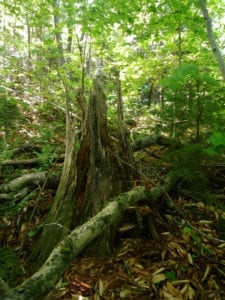
Old trees, large trees, structural diversity, snags, coarse woody debris, pit and mound topography, nurse logs, canopy gaps, broken-topped trees, mosses, lichens, and lack of human disturbance—these are characteristics of an old-growth forest in the Granite State. See “Finding Old-Growth Forests in New Hampshire,” an article by David Govatski, published by the University of New Hampshire Cooperative Extension.
As a forester and naturalist, I have had a life-long interest in forests. I have been fortunate to have been able to visit many old-growth forests throughout the United States. I have long recognized the need to preserve these old forests for many reasons. The scientific value of old-growth forests is well known, and several research forests have been created to study the dynamics of these original forests. There are many other reasons to protect old-growth forests, including preserving spiritual, cultural, historical, and biological values.
… People sometimes expect walking in an old-growth forest is like walking in a cathedral of big and tall trees. Sometimes it can feel that way, especially in some of our hemlock and white pine forests. But more often, you will find a chaotic scene of downed trees, areas of thick undergrowth, and trees of varying sizes. Walking off-trail can be difficult. Once a person learns to value old-growth forests, he or she will appreciate the aesthetics of the forest’s complexity. – David Govatski, Finding Old-Growth Forests in New Hampshire (via UNH-UC)
When it comes to the protection of old forests, Govatski feels we should aim for 10% of our forest land being old growth.
“In addition to identifying opportunities to protect existing or future old-growth on private land, we should encourage local, state, and federal agencies to identify, designate, and protect such forests on public lands,” wrote Govatski. “Ideally, we should have at least one old-growth forest designated in each of our ten counties.”
For information about the old forest on Mount Sunapee, see Natural Heritage and Ancient Forests (FOMS).
